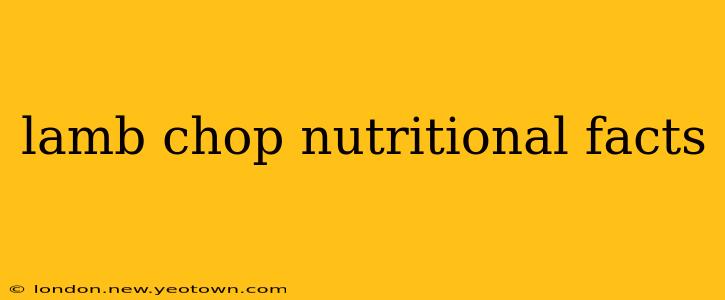Lamb chops, those succulent and flavorful delights, often grace our plates as a celebratory meal or a special treat. But beyond the delicious taste, there's a nutritional story to be told. Let's delve into the world of lamb chop nutrition, uncovering its benefits and potential drawbacks.
Imagine this: a sizzling lamb chop, perfectly cooked, releasing its tantalizing aroma. The juicy meat, tender and flavorful, is a culinary experience that satisfies both the palate and, to a degree, our nutritional needs. But how nutritious are they really?
What are the Nutritional Benefits of Lamb Chops?
Lamb chops are a good source of several essential nutrients. They are particularly rich in protein, crucial for building and repairing tissues, making them a great choice for athletes and those seeking to maintain muscle mass. A serving of lamb chops also provides a significant amount of iron, vital for oxygen transport throughout the body, combating fatigue and preventing anemia.
Furthermore, lamb chops are a source of vitamin B12, essential for nerve function and red blood cell formation, and niacin (vitamin B3), crucial for energy metabolism. They also offer zinc, an important mineral for immune function and wound healing, and selenium, an antioxidant that protects cells from damage.
Are Lamb Chops High in Fat and Cholesterol?
This is a question many people have about lamb chops. Yes, lamb chops can be higher in fat and cholesterol compared to some other protein sources. The fat content varies depending on the cut and how it's prepared. Leaner cuts of lamb chops exist, and choosing those and trimming away visible fat before cooking can significantly reduce the fat intake. Grilling or broiling, instead of frying, also helps minimize added fats.
Understanding the fat content is crucial. Not all fats are bad; some are essential for hormone production and cell function. However, excessive saturated and cholesterol intake can contribute to health issues. Moderation is key when enjoying lamb chops.
How Many Calories are in a Lamb Chop?
The calorie count in a lamb chop can vary drastically based on the size of the chop, the cut of lamb, and the cooking method. A typical 3-ounce serving can range from 200-300 calories. However, this can easily increase with added fats during cooking. Checking the nutritional information provided by your butcher or grocery store is always recommended for a precise calorie estimate.
How Much Protein is in a Lamb Chop?
A 3-ounce serving of lamb chop typically contains approximately 25-30 grams of protein. This substantial protein content makes lamb chops a satisfying and filling meal, aiding in satiety and helping with weight management when consumed as part of a balanced diet.
What are the Potential Downsides of Eating Lamb Chops?
While lamb chops offer numerous nutritional benefits, it's important to be mindful of potential downsides. As mentioned, the fat and cholesterol content can be relatively high. Individuals with high cholesterol or other cardiovascular concerns should consume lamb chops in moderation and consult with their doctor or a registered dietitian. The preparation method, as discussed, greatly influences the overall nutritional value.
Are Lamb Chops Healthy?
The healthfulness of lamb chops depends on several factors, including the cut, cooking method, and portion size. When consumed in moderation as part of a balanced diet, lamb chops can contribute valuable nutrients. However, excessive consumption, especially of fattier cuts, can negatively impact health. A balanced approach is key.
In conclusion, lamb chops offer a delightful culinary experience with a decent nutritional profile. By choosing leaner cuts, opting for healthier cooking methods, and consuming them in moderation, you can enjoy this delicious meat while minimizing potential drawbacks. Always consult with a healthcare professional or registered dietitian for personalized dietary advice.

